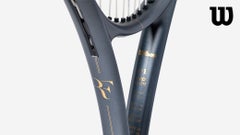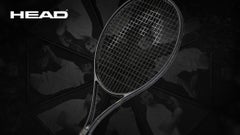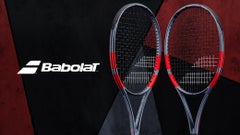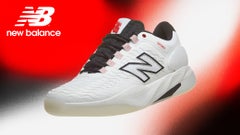Head Intelligence i.Prestige Review

If "Intelligence" is what Head is betting their money on then their latest IQ test has seemingly moved them near the head of the class. Their star pupils aced their last two exams, Gustavo Kuerten winning the French Open and Goran Ivanisevic topping the field at Wimbledon. Two men, two straight Major titles - both using Intelligence racquets.
The name "Prestige" is a familiar name to many advanced players and ATP pros who used (or still use) the now discontinued Head Prestige Classic 600 or Head Prestige Tour 300. They were both successful "players" racquets that were popular with players looking for a heavier racquet with good control and low power level. Attempting to improve upon a successful run with those racquets, Head introduces the first "intelligent" players racquets. The i.Prestige Mid and i.Prestige Midplus XL replace the Classic Tour and Classic Tour Midplus in the US and Prestige Mid and Prestige Midplus in Europe/Asia. Both new racquets feature intellifibers (which, according to Head, use the mechanical energy of ball impact and convert it - in less than a millisecond - into electrical energy).
Until now, intellifibers could only be found on some of Head's more powerful racquets, the i.S18, i.S12, i.S10, and the i.S6. We playtested the new i.Prestige racquets for two weeks to find out how well this new-fangled "intelligence" technology would work on the "old school" Prestige racquets. What we learned is listed below.
Head Intelligence i.Prestige Mid
Groundstrokes
The combination of its smaller, 93 square inch head and low power level lend the Intelligence i.Prestige Mid a serious "players racquet" tag. While it's lighter than many "players racquets", it still offers the control and stability we've come to expect from Head's Prestige racquet line. Don offers, "although the head is fairly small, stability was surprisingly impressive even during mis-hits. Balls hit in the upper hoop are a bit anemic but there was very little shock or vibration. Not enough power for me but precision was impressive. Compared to the Classic Mid, I found the i.Prestige Mid had a stiffer upper hoop and not quite as much feel; the Classic Mid has this 'loosy goosy' quality that's difficult to quantify. Suffice to say the racquets are similar but the i.Prestige does have a firmer overall feel." Dan adds, "those players faithful to the Prestige Classic and/or Prestige Tour will find a more comfortable, dampened feel with a slightly larger sweetspot that extends higher in the string bed. Intellifiber technology (Integrated on both sides of the throat area) may contribute to this feel - or not. Regardless, I found less flex towards the top of the frame/hoop." Keith says, "the added stability in the throat area was evident but I still felt some arm shock when hitting off center."
The hefty feel, high frame flex and dense (18x20) string pattern of the i.Prestige Mid drew mixed reviews regarding feel and spin potential. Mark comments, "I was able to hit solid, consistent groundstrokes with the i.Prestige Mid. I wasn't able to overpower my opponent but I was able to hit a lot of placement winners. The weight of the racquet kept my swing under control. This reduced my power but also reduced my mis-hits. I was able to sustain long rallies without babying the ball. In fact, any time I let up on a shot it ended up in the net. This is definitely a racquet for players who can generate some power on their own." Dan continues, "I did find the 18x20 string pattern very dense for a 93 square inch frame. It doesn't take a play test to realize this pattern favors flat ball strikers who prefer a very "direct" targeted ball - that's to say, little spin and straight. For spin artists like myself it's more of a lesson in frustration."
Granville says, "I liked this racquet from the moment I hit my first groundstroke. The i.Prestige Mid is heavy enough to drive the ball and soft enough to allow the ball to sit on the strings for that extra moment. On groundstokes it's back to basics. Nothing extra offered here, if your fundamentals are strong, you're going to enjoy the precision response of this racquet. Good depth and pace on back-court exchanges were a pleasure with this frame. I was giving myself some extra clearance from the baseline and didnÕt notice any issues with spin potential, which is always a concern with 18 main string patterns. I do hit a rather flat groundstroke so this would not effect me as much as other players who utilize heavy topspin."
Volleys
The power level of the i.Prestige Mid seemed to be the feature that influenced our playtesters the most on volleys. Mark begins, "the i.Prestige Mid is very stable at the net and had good control. However, I had trouble with the low power level and the small head size. My volleys were consistently short and weak. It also didn't feel as maneuverable as my Thunder 820 or the i.Prestige XL." Don concurs, "as expected, I found the i.Prestige Mid too low powered for my volley needs. However, just sticking out the racquet and blocking balls back worked pretty well in many cases. The problem was, my winners were simply balls that landed too short for my opponent to reach. Strong, aggressive net players may find the i.Prestige Mid more appealing. Short angle and touch volleys were more successful but generating spin, once again, was difficult due to the 18x20 pattern in a 93 square-inch head."
Granville, an aggressive net player, had a different take, adding, "love it! Crisp, precise, and lethal are three words that come to mind with regard to volleying with the i.Prestige Mid. I have a terrific sense of confidence at net with a racquet like this in my hand. No worries about spraying balls long or mis-hits. Just me, my racquet and my reflexes; just the way I like it." Dan continues, "I was a little skeptical of what to expect at net from such a flexible, densely strung frame with a 93 sq. inch head. My fears were quickly put to rest. The softer feel and dense string pattern combined for great directional control and produced a ball that found its target in a much quicker fashion than many open patterned competitors. Because of this, the confidence to 'stick' or really lay into volleys was there."
Serves
The i.Prestige Mid's weight and balance played the most critical role when it came to serving. While control and placement scored high on most of our lists, spin control suffered. Mark explains, "I served surprisingly well with the i.Prestige Midplus, although my arm did tire out after a while. My swing felt slow but my serves had good power and control. I wasnÕt able to get as much spin as I got with the i.Prestige XL but my control was a little better with the Mid and there was no noticeable decrease in power." Don adds, "I liked the i.Prestige Mid's weight and balance on serves. It has all the right components for being a solid serving stick - heft, head-light balance and small head. I hate to sound like a stuck record, but the only thing that held it back was the dense string pattern. Power was tempered and spin was difficult to generate."
Dan found a middle ground, commenting, "mentioning the dense string pattern of the Intelligence i.Prestige Mid may seem redundant, but it plays a large part in the spin potential of this racquet - particularly when serving. I found a trade-off here. While servers with flatter, more powerful deliveries will find an ideal choice here, I felt a crisp, clean sweep from the strings on contact. As on other strokes, it feels as if you're getting less dwell time on the strings - a quick "pop" if you will. Whether this is true is another story but it's a comforting feeling/sound." Granville summed up, "the benefit for the average (non-Kuerten level) player is the control afforded by its flexible shaft which allows for good control on wide serves and predictable response on serves down the middle and into the body. I never felt like I didnÕt know what the racquet was going to do. I did wonder what two less main (16) strings would do for spin potential and that kicker out wide."
Returns
Service returns followed a predictable pattern with most players having to supply more muscle for good pace and depth. Mark says, "On service returns I was able to hit out or slice the ball with equal ease. If I let up on slice returns the ball ended up in the net so I had to take a hefty swing no matter how I hit the return. However, since the racquet doesn't have much power you can take a full swing without worrying too much about the ball flying long." Dan continues, "My advice for anyone not prepared to swing large on return of serve is, 'carbo load the night before picking this racquet up.' For not so experienced players, this frame may feel like they're already in the 3rd set. But, swing large and swing confident. Half swings will more than likely land your reply short or into the net." Don adds, "Returning big serves was no problem - just set the racquet and block the ball back. The i.Prestige Mid's weight makes this possible. My returns weren't deep or powerful but the racquet was stable and I was able to direct the ball easily. Against second serves, I could take a good swipe at the ball and be confident it would land in the court."
Summary
It's no surprise that the i.Prestige Mid will play best in the hands of advanced 5.0 to pro level players with fast, full swings (who demand precision and control) and those who have the confidence to play with a smaller head size and denser string pattern. We found limited shock and/or vibration for such a serious player's stick at this balance and swing weight. It's difficult to say whether the added intellifibers at 5 and 7 o'clock are are the reason, but Head has definitely made a stride forward in their popular Prestige line. Current Classic Mid users will find almost identical weight, balance, swingweight and stiffness specs, as measured on the Babolat RDC. The most noticeable difference is a slightly stiffer upper hoop, which reduces feel somewhat but increases stability on off-center shots.
i.Prestige Mid Technical & Statistical Data
(Scores are determined by averaging individual play test scores)
|
|
|||||||||||||||||||||||||||||||||||||||
Head Intelligence i.Prestige Midplus XL Review
Groundstrokes
The i.Prestige Midplus XL offers a slightly larger head (98 square inches) and longer length (1/2 inch) than its smaller brother. While this racquet still requires some muscle to achieve depth and pace from the baseline, the i.Prestige Midplus Xl's combined features found favor with our play-testers. Mark explains, "I preferred the i.Prestige Midplus XL over the standard length Mid. I thought it was a little more powerful, produced a little more spin, and was more maneuverable. My groundstrokes with the i.Prestige XL were excellent. It's a little heavier than my usual racquet (Prince Thunder 820) and the extra weight helped calm my groundstrokes. I was able to hit the ball wherever I wanted with good (not great) pace. It doesnÕt have a lot of power but I was able to swing hard and keep the ball in the court. I was able to hit good flat groundstrokes and heavy topspin as well." Don continues, "The i.Prestige Midplus XL felt good from the first time I picked it up. I enjoyed the combination of weight, balance, swingweight, length and stability offered on groundstrokes. Even though prefer a more open string pattern I could still generate pretty good topspin and slice from the baseline. It required conscious effort, but the result was better than with the Mid. The racquet has an impressively solid, comfortable feel and it was stable on a variety of off-center hits. Power wasn't quite enough for my medium strokes but after adjusting my swing I was able to hit the ball deep and with adequate pace. Similar to the Mid, I found the i.Prestige MP XL very similar to the Classic Tour Midplus, except for a slightly stiffer upper hoop. This wasn't a negative though, and served to improve stability. The extra 1/2 inch of length was also welcome, providing added leverage and pop without any noticeable disadvantages."
Granville says, "After playing with both racquets I prefer the longer Midplus for the simple reason that if feels 'softer', probably due to the extra 1/2 inch in length. The first playtest I was playing with a ball machine and hitting at targets in each baseline corner. I was hitting the targets with regularity and found myself not thinking about the racquet at all (other than the possibility of switching from my current racquet!). It had a very soft, comfortable feel with precise control, whether exchanging crosscourt or driving the ball down the line. As to be expected, the racquet is very low on the power scale so (like the Mid) your game has to be in order to play with this racquet.
Dan sums up, adding, "I felt an immediate boost in groundstroke spin potential compared to the standard length Mid, no doubt a product of the same 18x20 string pattern, but supported in a larger 98 head size. A nice increase in leverage (due to the longer length) was a welcome addition as well. Whatever areas certain advanced players may find lacking in the Mid standard, the Midplus XL gives a little back - larger head, more open string pattern, longer length, a little more raw power, a slightly thicker beam for increased stability, and just as (or more) maneuverable at a lighter overall weight. Head did an excellent job finding an appropriate balance while increasing length. Although I knew the extra leverage was there, it balanced and swung like a standard length 12oz. 'players' frame. I appreciate the craftsmanship here."
Volleys
Comfort and control were two words our play-testers commonly used to describe their trips to the net with the i.Prestige Midplus XL. Granville explains, "I was delighted with the comfort of this racquet. I could move from side to side and have the racquet right out front for volleys from anywhere on the court. Control was so good I experimented with various touch angle and drop shots." Don says, "capable net players should love the i.Prestige Midplus XL on volleys. It's maneuverable, yet hefty enough to provide stability against hard-hit passing shots. The ball comes off the stringbed with predictability, albeit with a little less power than I prefer. There's plenty of control though, and good touch for short angle and drop volleys."
Dan continues, "When dealing with flexibility at this level, providing your own power on volleys is a constant. Proper form and experience pay off here. Better spin control and off center feel were evident from the beginning (in comparison to the Mid standard). I felt maneuverability was actually about the same - a testament to this frame's balance and swing weight." Mark ends, "I'm used to a stiffer racquet with a bigger head so I had to hit my volleys a little harder with the i.Prestige Midplus XL than I do with my regular racquet. I did have good control on my volleys with this frame, and I was able to hit out on half-volleys without worrying about them flying long. I found it stable on mis-hits. Very little shock or vibration reached my arm on off-center volleys."
Serves
Most of our play-testers found similar attributes/feel to the i.Prestige Mid when serving. The larger head size and longer length of the Midplus XL produced some of the more obvious differences. Don expressed some common sentiments, "I felt confident serving with the i.Prestige Midplus XL. It had most of the attributes of the smaller Mid but allowed me to hit better slice and topspin serves. There was enough power to crank the big first serve down the middle and enough control to direct the ball at will. Dan says, "Power and pop were about equal to the Mid standard but I was more confident moving the ball around the service box thanks to increased slice and kick height. I felt like I had more options (again, in comparison to the i.Prestige Mid) thanks to obvious physical differences. Generating extra racquet head speed over a few sets didn't seem to tire my arm either - this frame is a real nice weight (11.8 ounces) to swing quickly with, while still producing results generally associated with heavier racquets." Mark agreed, adding, "I was surprised at how well I served with the i.Prestige Midplus XL. I had great control, which I expected, but I also had good power and spin on my serves. I was worried that the weight of the racquet would wear my arm out over time, but I was able to hit strong serves for an entire match. It didn't feel like the racquet was moving very fast on serves, but the ball really jumped off the strings. I got good kick on my second serve, too."
Returns
The slightly higher power level, thicker beam construction and increased reach lend the i.Prestige XL some advantages evident to all our play-tester's when returning serve. Dan observes, "increased stability (in comparison to the Mid standard) was a noticeable characteristic on service returns. The slightly thicker beam and larger head help here. However, these qualities won't excuse anyone not willing to help themselves on returns. A healthy dose of personal swing power goes a long here. You'll regret less than full swings with short replies that immediately put you on the defensive against better/experienced players." Don adds, "I hit some pretty good returns with the i.Prestige Midplus XL. It's maneuverable enough to take a short backswing against all but the biggest serves and stable enough to effectively block back the big ones." Granville adds some useful advice, "My only real issue with this racquet (as well as the standard Mid) is the tight string pattern. I never really felt like I was 'grabbing' the ball which would aid greatly when returning serve. I recommend using a 17g. string for increased bite and spin control, particularly if you play regularly against big/hard server's."
Summary
Head did a nice job of maintaining a very maneuverable swingweight with the increased length, frame thickness and head size of the i.Prestige Midplus XL. Although still considered to have a dense string pattern, increased spin control (topspin and slice) and overall power will be welcome attributes for more advanced players who may find the i.Prestige Mid (standard) a bit too underpowered and/or limiting under faster playing conditions. The i.Prestige Midplus XL offers the benefits of the i.Prestige Mid but in a more user friendly package.
i.Prestige Midplus XL Technical & Statistical Data
(Scores are determined by averaging individual play test scores)
|
|
|||||||||||||||||||||||||||||||||||||||
Playtester Profiles |
|
| Dan | 5.5 all-court player currently using a Prince Triple Threat Warrior MP. |
| Don | 4.5 all-court player currently using a Yonex Ultimum RQ Ti-1700 MP. |
| Granville | 5.5 all-court player currently using a Wilson Hyper ProStaff 6.1 95. |
| Keith | 5.0 player currently using a Prince Precision Response Ti. |
| Mark | 5.5 all-court player currently using a Prince Thunder 820 OS. |
Review date: August, 2001. If you found this review interesting or have further questions or comments please contact us.
All content copyright 2001 Tennis Warehouse.












